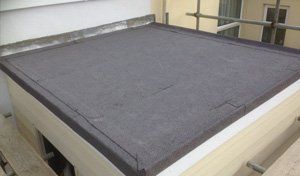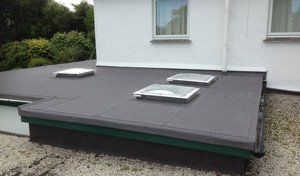Felt Roofing
Felt roofers serving customers across Cornwall
The felt roofers at Premier Mastic Asphalt have a wealth of experience in handling a wide range of flat roofing projects for customers in St. Austell and throughout Cornwall.
Polyester felt reinforcement bases
A non-woven polyester fabric which is rot-proof and very strong. Available in a variety of weights –
Contact
- Lighter weights are normally used as underlays, providing added strength, resistance to tearing and good nail holding properties.
- Heavier weights have higher puncture resistance and are normally used for cap sheets.
Types of coating compounds
- Oxidised bitumen (unmodified)
- SBS (styrene-butadiene-styrene) modified bitumen – a rubber modified elastomeric bitumen, which provides superior low-temperature flexibility and the ability to cope better with movement, without fatigue cracking.
- APP (atactic polypropylene) modified bitumen - Polymer modified bitumen, which makes the product particularly suitable for application with a gas torch; good resistance to slump and improved lower temperature flexibility. APP modified bitumen membranes are ideal for use as an overlay to existing asphalt and some felt roofs

Application methods
Pour and roll
Hot bitumen is poured (or applied by a mop) in front of the roofing felt roll, which is then unrolled into the bitumen, spreading it to give a continuous coating for the full width. Most bitumen roofing is applied with minimum 50 mm side laps and minimum 75 mm end laps.
Torch applied
A torch flame is played on the underside of the roll until a molten coating runs downs to form a continuous flow. The felt is then rolled forward into the flow of the bitumen, whilst the torching operation continues, allowing continuous bonding and ensuring that air is not trapped under the roofing.
Types of flat roof
- The cold roof - A cold roof is where the principal thermal insulation is placed at or immediately above the ceiling, resulting in the roof covering and structural deck being substantially colder in winter than the interior of the building.
- The warm roof - The warm roof is where the principal thermal insulation is placed immediately below the roof covering resulting in the structural deck and ceiling being at a temperature close to that of the interior of the building.
- The inverted roof - The inverted roof is where the principal thermal insulation is placed above the roof covering, resulting in the roof covering, structural deck and ceiling being at a temperature close to that of the interior of the building.

Guarantees
10 year or 15-year insurance backed guarantees are offered.
Types of surfaces
- Sanded
- Mineral
- Slate
Colours
- Green
- Blue-grey
- Brown
Installation
- Structural base
- Rigid insulation boards
Coverings
- Solar reflective paint
- Spartan porous concrete promenade tiles
Vapour control
In almost every old roof structure moisture has usually penetrated through either by damage, weathering or stress cracks. With the action of sunshine, this can convert trapped moisture into water vapour; with a volume of up to 1500 times its original value. If this vapour cannot be released, blistering may occur, destroying the waterproofing integrity of the membrane. Vapour pressure can be much stronger than the original bitumen bond and is capable of destroying the seal between layers of waterproofing.
For all your flat roofing needs in St. Austell and throughout Cornwall, get in touch with the felt roofers at Premier Mastic Asphalt. Call us now on
01726 822 918
Thank you for contacting us.
We will get back to you as soon as possible
We will get back to you as soon as possible
Oops, there was an error sending your message.
Please try again later
Please try again later



© 2024. The content on this website is owned by us and our licensors. Do not copy any content (including images) without our consent.





